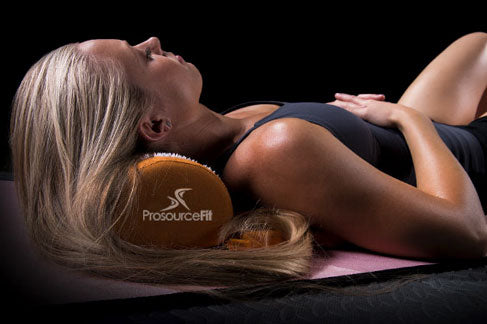How to Use an Acupressure Mat to Reduce Muscle Pain
You lift weights to get strong and look your best, you do yoga to stay flexible, and you run regularly to keep your heart healthy. But do you still feel less than your best?
It can be seriously frustrating when your body is stiff and achy, or you can’t seem to get enough sleep. When your energy and recovery are suffering, you can’t perform at your best. In fact, you may even have to take time away from your workouts.
If you struggle with pain, low energy and poor recovery, an acupressure mat may be exactly what you need!
What is an Acupressure Mat?
The ProsourceFit Acupressure Mat and Pillow set is a simple foam and cotton mat covered with almost 8,000 sharp plastic points. This "bed of nails" design stimulates the body's meridian lines and helps to increase blood flow wherever you use it – back, neck, shoulders, legs, glutes, or stomach.
Blood circulation plays a crucial role in recovery, because blood is what delivers nutrients to muscles to help them rebuild and repair. Blood flow also removes waste from muscles and reduces inflammation and its accompanying pain.
The acupressure pad’s benefits include:
- Release of feel-good endorphins
- Reduced pain and muscle tension
- Improved blood circulation
- Stress relief
- Increased energy
- Sleep induction and better sleep quality
Reduced Pain & Improve Sleep
One study had users suffering from chronic neck pain and/or lower back pain test the benefits of needle stimulation pads. After using it for 30 minutes daily for 14 days, results showed that pain ratings were reduced significantly compared to the control group.
Sleep is another critical component of well-being and muscle recovery. During the night, human growth hormone is released, and the body restores organs, tissues, and the immune system. Quality rest is important for protein synthesis and recovery from exercise. Also known as sleep induction mats, the acupressure mat promotes relaxation to help you fall asleep faster and improve sleep quality.
So, whether you suffer from post-workout soreness and tightness, deal with chronic pain, or need help inducing sleep, regular use of a “bed of nails” in the comfort of your own home can help you feel better and recover faster!
Acupressure Mat Routine
Try the following therapy routines for your specific area of pain. For best results, lie on the mat with bare skin. You can also wear light clothing or use a thin sheet on top of the mat until you get accustomed to the sensation. You may experience some initial discomfort as your body adjusts to the feeling of the pressure points. Breathe deeply and relax, and the discomfort should diminish within a few minutes.
- Beginners: 5-10 minutes per day
- Intermediate: 15-20 minutes per day
- Advanced: 30- 45 minutes per day
- You may also use it for shorter durations multiple times per day as needed
Neck & Back Therapy: Soothes back & neck pain, headaches, and promotes sleep
- Lie on a flat surface with your back on the mat and pillow directly under your neck; rest arms by your sides.
- For more lower-back contact, bend knees with feet flat on the floor in front of you.
Chest & Abdominal Therapy: Reduces chest soreness, aids digestion, soothes cramps
- Lie on your stomach with head off of the mat, resting chin on hands.
- OR, lie with one cheek on the neck pillow with a sheet in between to help relax the face and jaw.
Lower Back & Buttocks Therapy: Soothes low back pain, reduces leg soreness, promotes good posture
- Place the mat on a chair with a slight fold, so your gluteus and lower back are both in contact with the mat.
- Carefully sit fully against the mat and back of the chair.
- Try this when working at a computer to multitask!

Legs: Reduces leg pain, promotes recovery
- Hamstrings: Sit on the edge of the mat and extend legs out in front of you.
- Quadriceps: Lie face down on the floor, with the mat under your hips and front of legs.
- Outer Thighs: Sit sideways on the mat with legs together and knees bent. Place arm on the ground for support.
Feet: Reduces foot tension
- Stand on the mat or sit in a chair with feet on the pillow
Sources:
https://www.ncbi.nlm.nih.gov/pmc/articles/PMC3446809/
https://breakingmuscle.com/fitness/whats-happening-in-your-blood-after-a-workout



